Turtles are one of those exotic pets that seem like such adorable little companions. Who doesn’t want one of these shelled little guys in their home?
![8 Small Turtles That Make Great Pets 1 7 [small turtles] that make great pets](https://petdt.com/wp-content/uploads/2022/03/7-Small-Turtles-That-Make-Great-Pets.jpg)
But despite their appearance, turtles can be quite a handful. They need lots of space to roam around and thrive.
Fortunately, one of these problems can be solved by simply buying a smaller turtle species as a pet.
If you’re looking for a great shelled buddy, then check out our list of the top 7 small pet turtles!
1. Red-Eared Slider
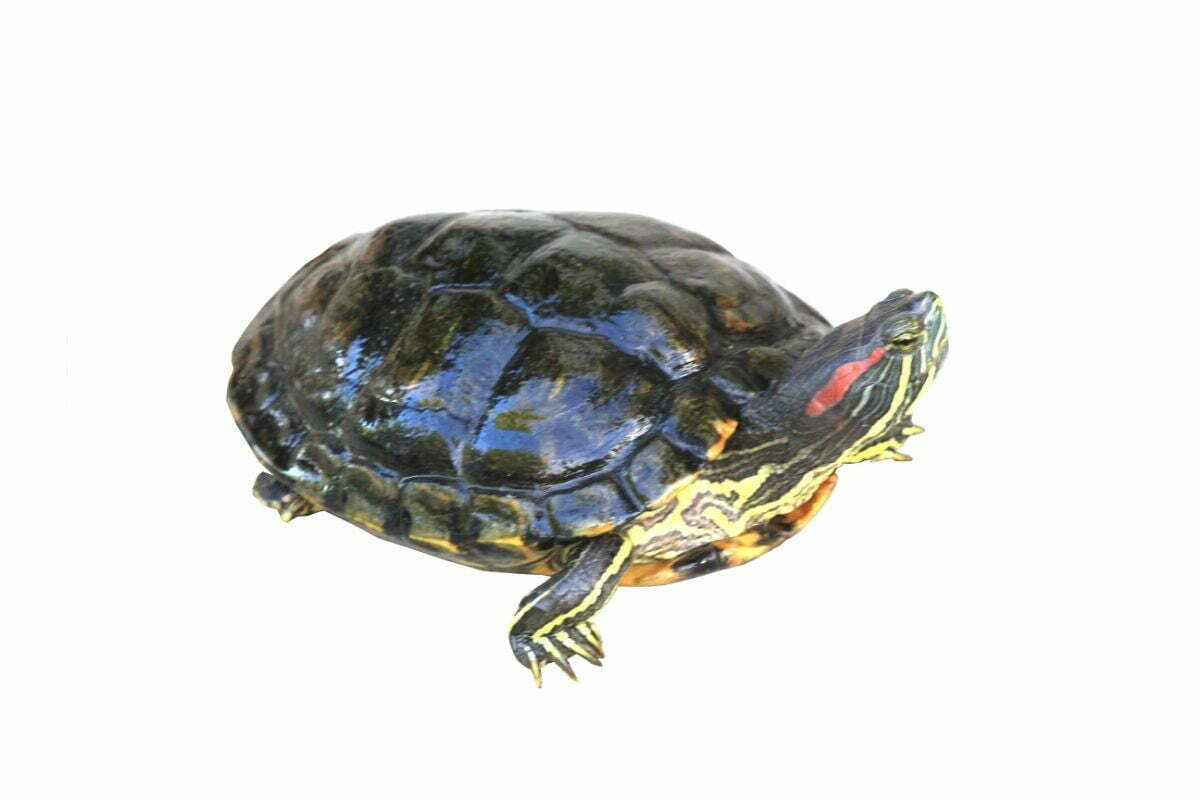
Starting our list off strong, if you’re looking for the perfect terrapin pet, then it is hard to have a conversation about the best pet turtles without mentioning the Red-Eared Slider Turtle.
This is the species that everyone recommends when first considering getting a pet turtle. And while it may not be the smallest turtle species on this list, they are considered one of the best species to care for and look after for people who aren’t familiar with reptile pet needs.
Red-eared slider turtles are one of the most popular pets for people looking for a reptile to keep as a pet. They are relatively inexpensive, easy to care for, and require little maintenance.
They are native to North America and are found in ponds, lakes, streams, and rivers.
The average size of these turtles varies from 6 inches to 12 inches long. The males tend to be larger than the females. Because of this, they have often been considered a medium-sized species, at least when discussing them in their capacity as pets.
Requirements
Thanks in part to their widespread use as pet animals, a lot is known about keeping this species of turtle healthy and happy.
Red-eared sliders are considered a beginner species when it comes to pet care, meaning that this is an animal that can be recommended to most to-be turtle owners!
Regarding their diet, red-eared sliders are herbivorous and will only eat plants or plant-based reptile feed. If you want to change their diet, leafy green vegetables, such as lettuce, green beans, and cucumber, are a great way to add variety to your turtle’s diet.
These turtles are very active and will need plenty of space to move around in. It’s important to provide them with an area where they can rest after being active.
On a similar note, being a medium-sized turtle pet, red-eared sliders require a decent amount of room in their tank or enclosure to remain occupied and healthy.
Because of this, they are recommended to live in tanks between 10 gallons and 30 gallons in volume.
Their ideal temperature ranges between 75°F and 85°F. Some experts recommend staying slightly above 90°F to ensure proper hydration, although you should check with a reliable pet provider or vet to make sure that this is safe for your turtle.
Pros
- A classic turtle pet species.
- A great beginner species for people who are new to looking after turtles.
- Thanks to its popularity, a wealth of information and advice is readily available.
- If herbivorous turtle feed isn’t available to buy, leafy greens are a healthy and easy way of feeding them.
Cons
- This is not a small breed of turtle. As a medium-sized species, you will need to find a larger living space for them.
2. Eastern Box Turtle
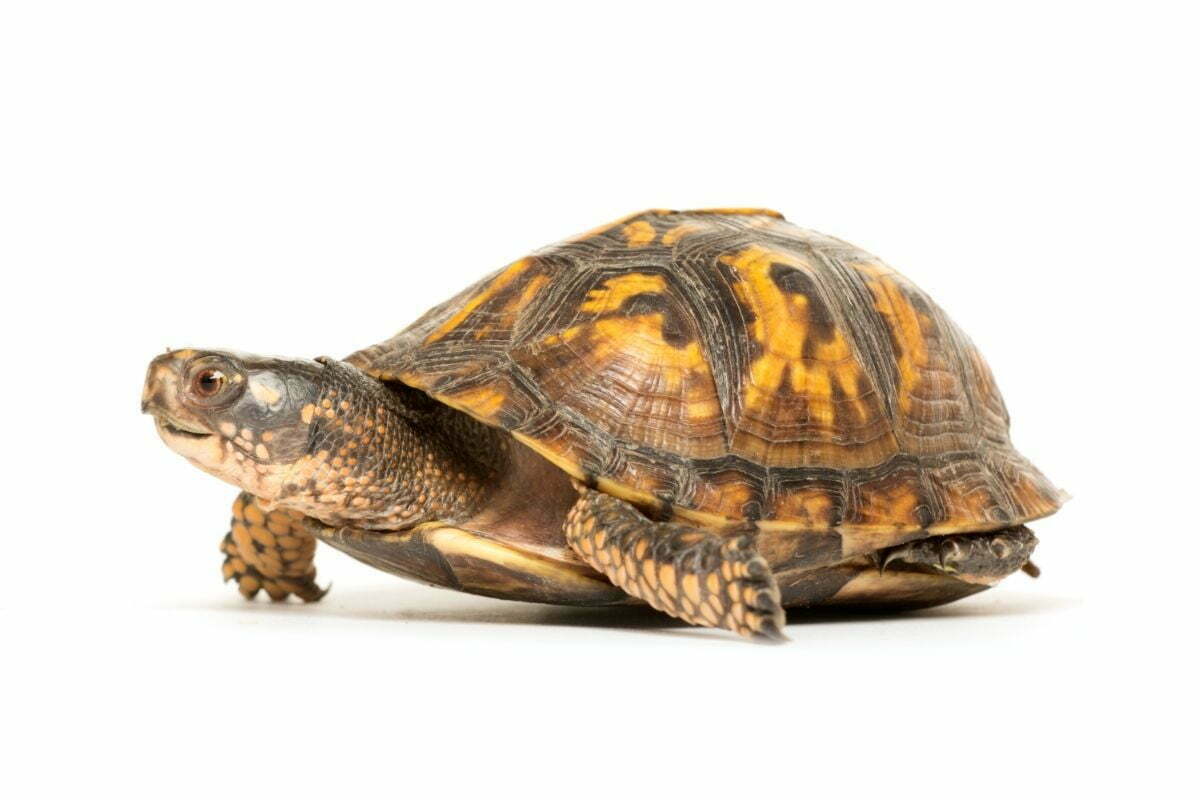
Another popular species of turtle that many people love looking after, the eastern box turtle, is a reptile of choice that is kept as a pet all around the world. What’s more, they are only 4 to 7 inches long and are a small turtle species!
While they are less common than some other types of turtle, as they are a vulnerable species in the wild that has seen a steady decline, they are still quite commonly seen as a pet species.
Unlike most turtles, which have a shell that curves upward toward the tail, the eastern box turtle has a straight tail shape and a flat top.
While this may sound unappealing on paper, it makes for a much more comfortable environment for the eastern box turtle during walks and activities.
This also gives the turtle a better chance of avoiding predators since they’ll have a harder time climbing over something that they don’t feel comfortable sliding under.
Requirements
So, with all this in mind, how exactly should you go about looking after your eastern box turtle pet? Should you choose to get one?
Well, generally speaking, eastern box turtles are a small turtle species, so space isn’t necessarily going to be the biggest concern for these turtles.
However, eastern box turtles are considered to be a land turtle species, meaning that they share many features in common with tortoises in regard to the environments they like.
As such, aquarium tanks should be discarded in favor of a classic reptile terrarium, with plenty of places to bathe under UVB lighting. They do still need a little water, though, so keep this in mind when trying to get your conditions just right.
When it comes to food, these turtles are generally herbivorous, eating plants, leaves, and fruit. They will happily eat many green vegetables and dandelions if normal turtle feed isn’t available.
However, there are no official guidelines when it comes to feeding your turtles, and if you can get your hands on some tropical fruits, then by all means, give those a try to see what your turtle likes best!
In terms of keeping them happy, these turtles will enjoy basking in sunlight, playing in the water, and having access to both fresh air and shade.
Many people choose to keep their box turtle pets in outdoor pens in warmer conditions, where they thrive! Of course, this may not be an option for everyone, but you should certainly consider this if your resources permit and the weather is right
Pros
- Generally require less water than most turtles in their tank, being a land turtle
- A great small breed for those looking for tiny turtles to look after
- Can eat many green plants and vegetables
Cons
- For the best quality of life, this turtle should be kept in an outdoor pen, which may not be feasible for everyone.
3. African Sideneck Turtle
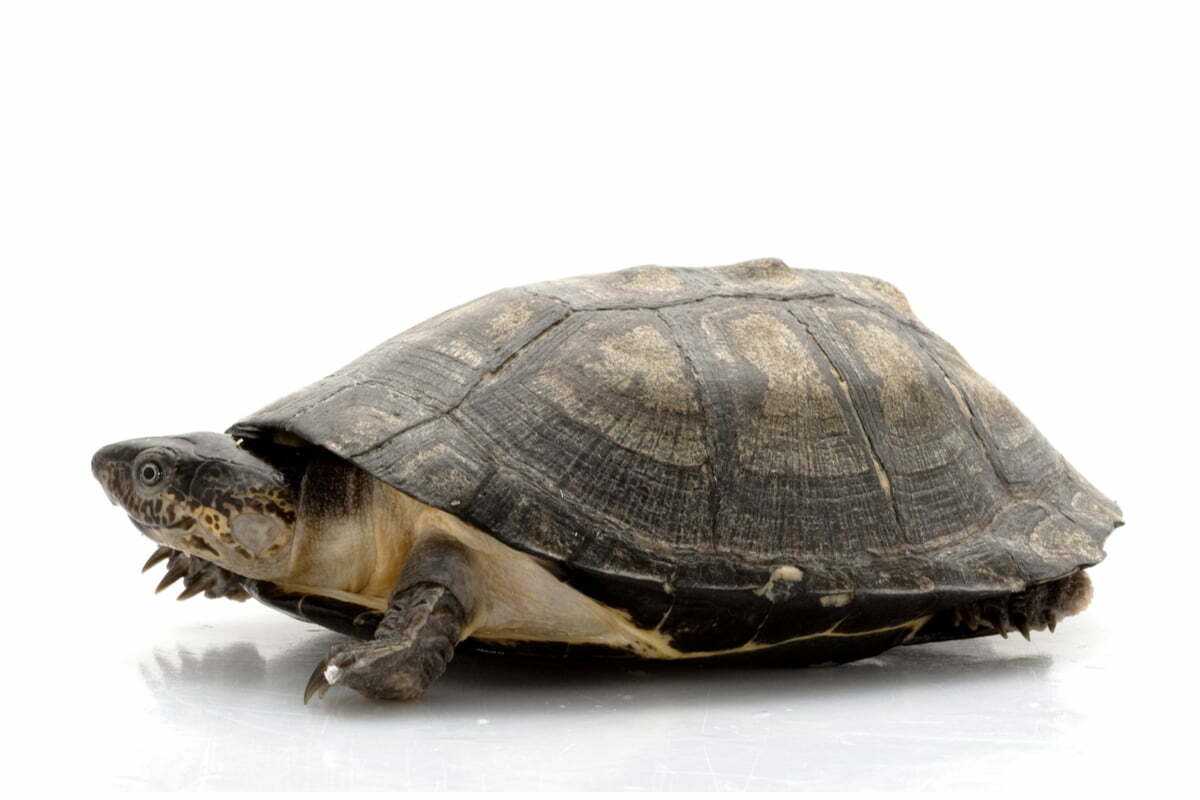
If you are looking for a small species of turtle that will stand out from other kinds of terrapin pets, then perhaps you should take a look at the African Sideneck turtle, to see if this might be the right animal companion for you.
They are known for their laid-back personalities and friendly nature. They are extremely affectionate and enjoy human companionship.
It is for these reasons, as well as their very distinct appearance that African Sideneck turtles are one of the most popular pets among people worldwide.
The African Sideneck turtle has soft bodies, with scales that resemble leather. Their skin color ranges from tan to gray-brown, while the markings are usually a similar color.
This species is most well-known for both its large flat head, as well as its inability to fully retract its neck into its shell.
The eyes of the Sideneck turtle are large and round, and they have long legs with webbed feet. These turtles grow up to about 8 inches long, although some can grow as large as 12 inches long, which certainly stretches the definition of what counts as a ‘small’ turtle species!
African Sideneck turtles prefer to stay warm, very rarely going into a temperature lower than 70 degrees Fahrenheit, and prefer to stay in streams and ponds of running water.
Requirements
When it comes to caring for these turtles, there is plenty that needs to be considered for this species. While it is considered a beginner-friendly animal to look after, they are certainly some of the more demanding animals in this category.
Thanks to their sensitive disposition when it comes to water hygiene and temperature, they need to be kept in water that is clean, clear, and free of debris.
If possible, make sure that the water is between 80 and 90 degrees Fahrenheit and that it has been filtered through sand or gravel.
They’re also going to need a large tank, as they love to swim in large bodies of water. 75 Gallons is considered a minimum that your turtle should have access to, which is quite a lot for this sized turtle.
Fortunately, food and other nutrition are quite an easy thing to manage when it comes to these animals. When it comes to food, these turtles are generally herbivorous, eating plants, leaves, and fruit. They will happily eat many green vegetables and dandelions if normal turtle feed isn’t available.
While these turtles aren’t great for handling (they are technically still a wild species), they are very interested in the world around them, meaning that they are often curious about their owners and will swim up to them if given a chance.
Just make sure that you aren’t forcing them to interact with you, as this can make them aggressive and defensive. And a bite from a turtle is something that you want to avoid!
Pros
- This is a friendly and inquisitive species that will be tons of fun to look after and watch!
- They can eat a whole range of veggie goods, from carrot slices to lettuce!
- A truly unique-looking species of turtle. There’s nothing on Earth quite like it!
Cons
- This is a high-maintenance species, as its tank will require more regular cleaning than other species of turtles.
4. Map Turtle
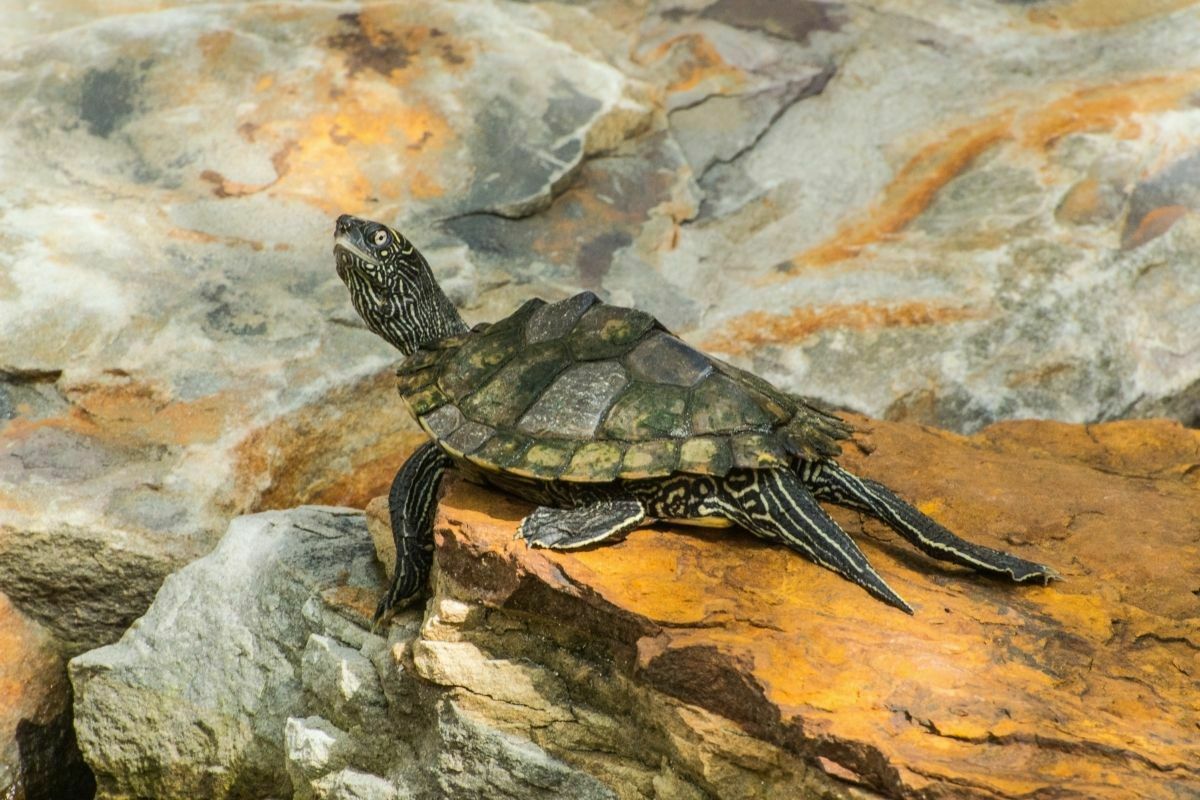
The map turtle refers to quite a large family of different species that make up this clan of particular reptiles. However, they share enough features in common that we feel comfortable outlining them and their needs in one entry in this guide.
Map turtles are one of the most popular pet turtles available. They are relatively easy to care for, and they are extremely intelligent. They are known for the distinct lines and patterns that grow on their carapace and body, which often bear a resemblance to map topography and layout, hence their name.
Not only that, but they are also quite friendly, and they do well in aquariums, thanks to their inquisitive nature and being particularly strong swimmers for their size.
They have some of the largest variety when it comes to their size. Some examples of this species are only 5 inches long, making them certified small turtles. Others meanwhile will grow up to 12 inches in length, over twice that!
Requirements
These turtles, being beginner-friendly, are generally quite easy to look after and handle.
They need to have a large space to move around in. This means bigger tanks than those generally owned by beginners. Really… the larger, the better.
A minimum of 50 gallons is recommended. Although a smaller example of this species may be able to tolerate 40 gallons, this is not ideal for their long-term health.
Feeding is fairly simple, as they are omnivores, and they enjoy a wide variety of foods and veggies. The best things for them to eat include carrots, celery, broccoli, cabbage, spinach, lettuce, onions, and dandelion greens. However, they also enjoy eating many insects when possible.
If you want to keep your turtle engaged with their food, many reptilian and exotic pet stores have a wide variety of insects for your pet to eat.
As previously mentioned, they are also going to need plenty of room to exercise, so you should consider getting them a terrarium or at least a pool of some kind so that they can get out and play.
In terms of housing, these turtles need a good deal of space to roam about freely, so you’ll probably want a big tank.
It might even be worth considering building a custom enclosure that accommodates their activity needs, as they don’t like being picked up, and these turtles can live for up to 40 years, although this is an expensive option that not everyone can afford
However, they can coexist with other turtle species, making them quite good for mixed enclosures that can accommodate their needs.
Pros
- They are very sociable turtle species and can peacefully live with other species.
- They can eat a wide variety of leafy greens, standard turtle feed, and insects!
- Distinct patterns and excitable personalities make them very interesting to observe and watch.
Cons
- This turtle species do not like to be held, so may not be ideal for younger households
5. Western Painted Turtle
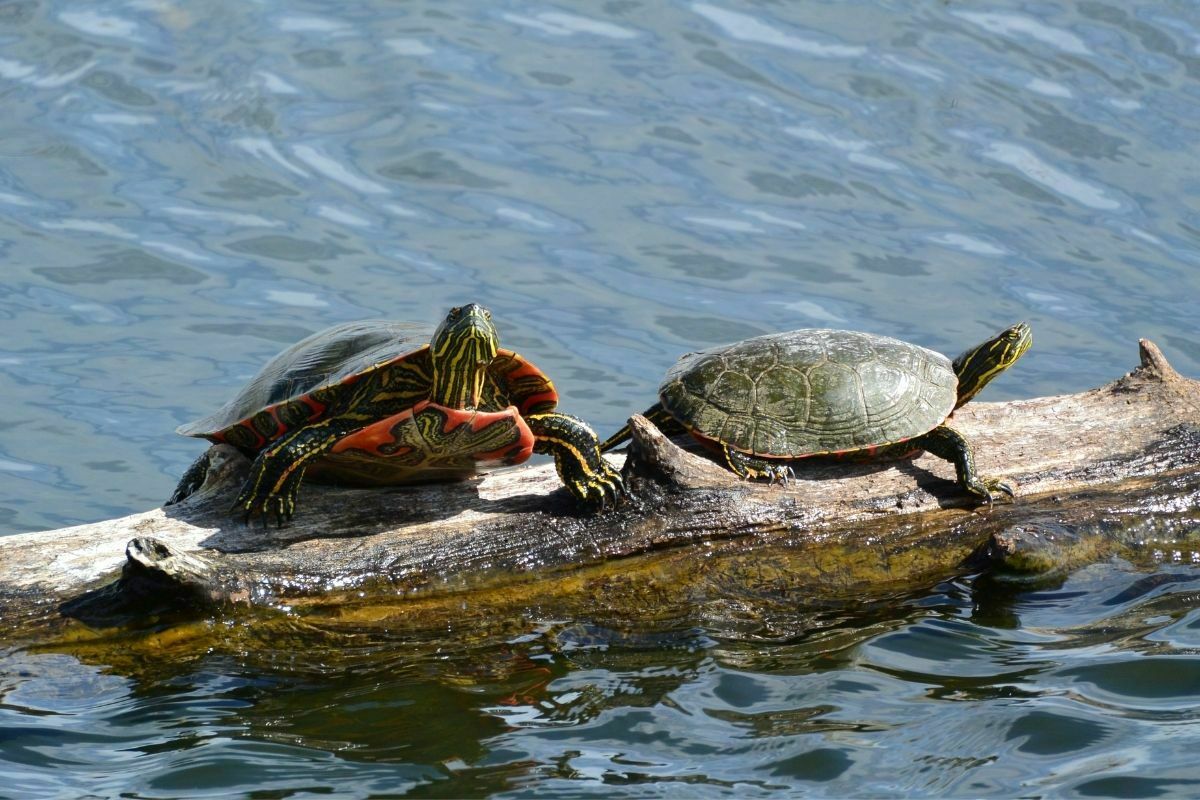
The Western painted turtle (Chrysemys picta bellii) is a member of the family Chrysemys. These turtles can be found throughout North America, from Alaska down to Mexico. Their coloration varies widely between individuals, depending on where they were born.
Typically, the male has a light greenback, while the female’s back is more brownish, with dark stripes running across her shell. Each individual has a unique pattern, but most specimens have some common characteristics.
Their heads are usually rounder and longer than other turtles, and they often have distinctive orange, yellow, or lime-green stripes running through their eye area.
They do not have any spots on their shells, but the contour lines across their carapace plates give them a very unique appearance.
Their tails are typically quite stubby when compared to other turtles and are covered in black scales.
The average lifespan of this turtle is 15 to 20 years, although some specimens have lived up to 30 years old. These aquatic turtles also tend to be more active during the summer months, as they are adapted to living in the water.
Requirements
These turtles may be a small species, but that does not mean that they enjoy living in small enclosures and aquariums. They need plenty of space in their enclosure to stay fully stimulated and happy.
Because they are aquatic animals, they require a large amount of fresh, clean water to drink and bathe in.
This species of turtle is omnivorous, meaning that they will eat many types of plants, small fish, crustaceans, and insects in their diet. So there are plenty of different foods that you can incorporate into their meals!
You will also need to provide them with sufficient hiding places, as well as a safe place for them to sleep. This is especially important if you plan on keeping them outdoors.
This is a very shy species that tend to hide at signs of trouble or predators, so don’t feel put off if your turtle hides from you when you approach its tank when you first meet it. It will warm up to you eventually.
If you choose to keep your turtles outside, you will need to provide them with a suitable habitat. You will also need to ensure that it is free of predators, such as snakes and raccoons.
Pros
- Unique patterns and lines make this species a unique pet to look at.
- With no examples growing larger than 10 inches, this is a pretty small turtle species!
- A large and omnivorous diet makes this turtle pretty easy to source food for.
Cons
- This species requires a large aquarium to swim around in.
- As this species loves to eat and swim at the same time, food that is not eaten may get stuck in your tank’s filtration system.
6. Spotted Turtle
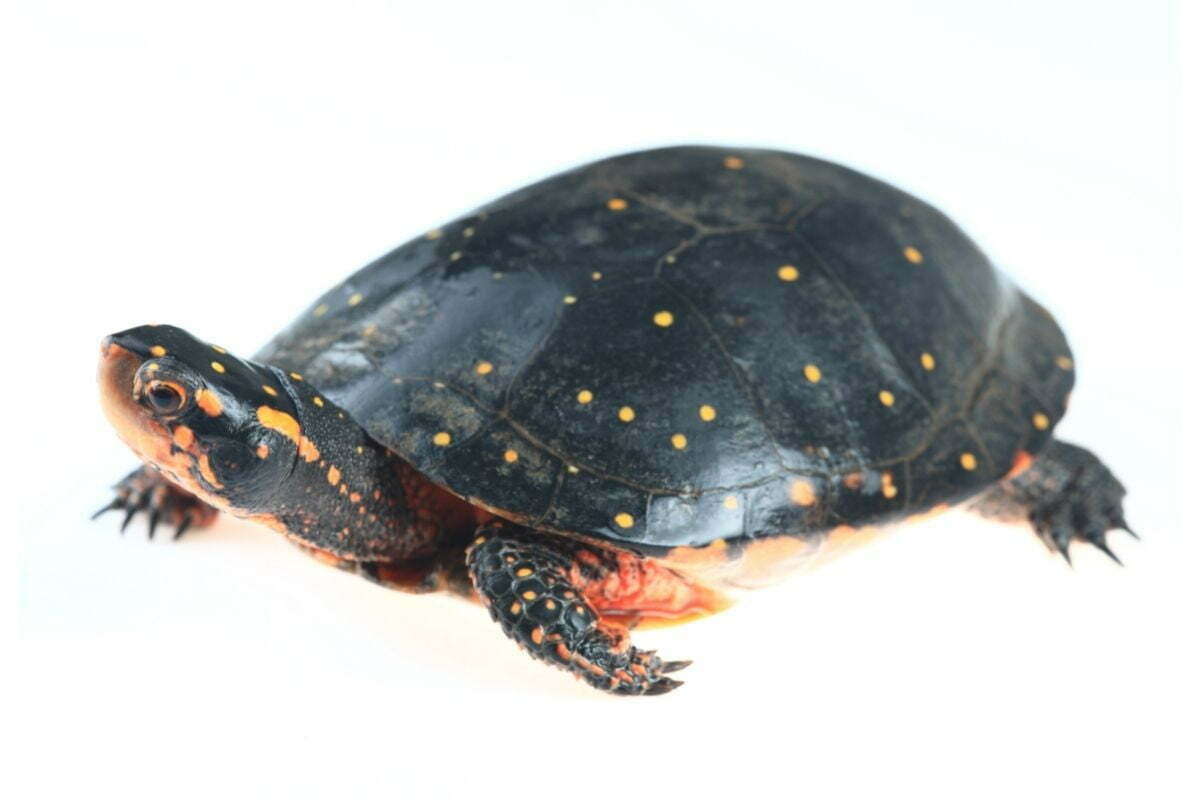
The Spotted turtle is probably one of the smallest species of turtle on this list of already very small species. At no more than 5 inches long in some cases, this is certainly a title that it deserves!
The coloration of the Spotted turtle varies between individuals, but they usually have a white belly, a dark blue-gray body, and a similarly colored head. Their tails are typically the same color as well, though occasionally, they can be pink.
Each specimen has a unique pattern of spots which gives this species its name, which varies in size and shape. Some have two rows of spots along their backs, while others only have one row.
This species can be found in the wild across the Eastern United States and parts of Central America, Mexico, and South America. Like most other turtle species, these little guys like to live near bodies of water where they can find shelter and food.
They are relatively slow-moving creatures that prefer to spend most of their time resting or basking in the sun.
Requirements
All these characteristics translate to a species that is a very laid-back pet that can be an absolute delight to take care of, although there are a few things that should be kept in mind when owning one as a pet.
For one thing, despite their love of water, they are not very strong swimmers and can struggle in water tanks that are too deep for them. If you want to avoid them drowning, you should make sure that their tanks are kept very shallow.
These turtles love to bask in the sun, so make sure that they have an appropriate UVB lighting bulb to give them the exposure that they need, especially if you are keeping them indoors.
These turtles are omnivorous, meaning they love eating many different kinds of food, from vegetables to plants to insects, and they even hunt fish on occasion!
Keep in mind that this is a long-lived species when buying one. With some examples living over 100 years, this turtle might just outlast you!
Pros
- This is a very small species of turtle, perfect for smaller homes!
- Has a wide omnivorous diet, so can be fed many different things.
Cons
- Not being strong swimmers makes it somewhat anxiety-provoking to leave them unattended, especially in deep-water tanks.
7. Musk Turtle
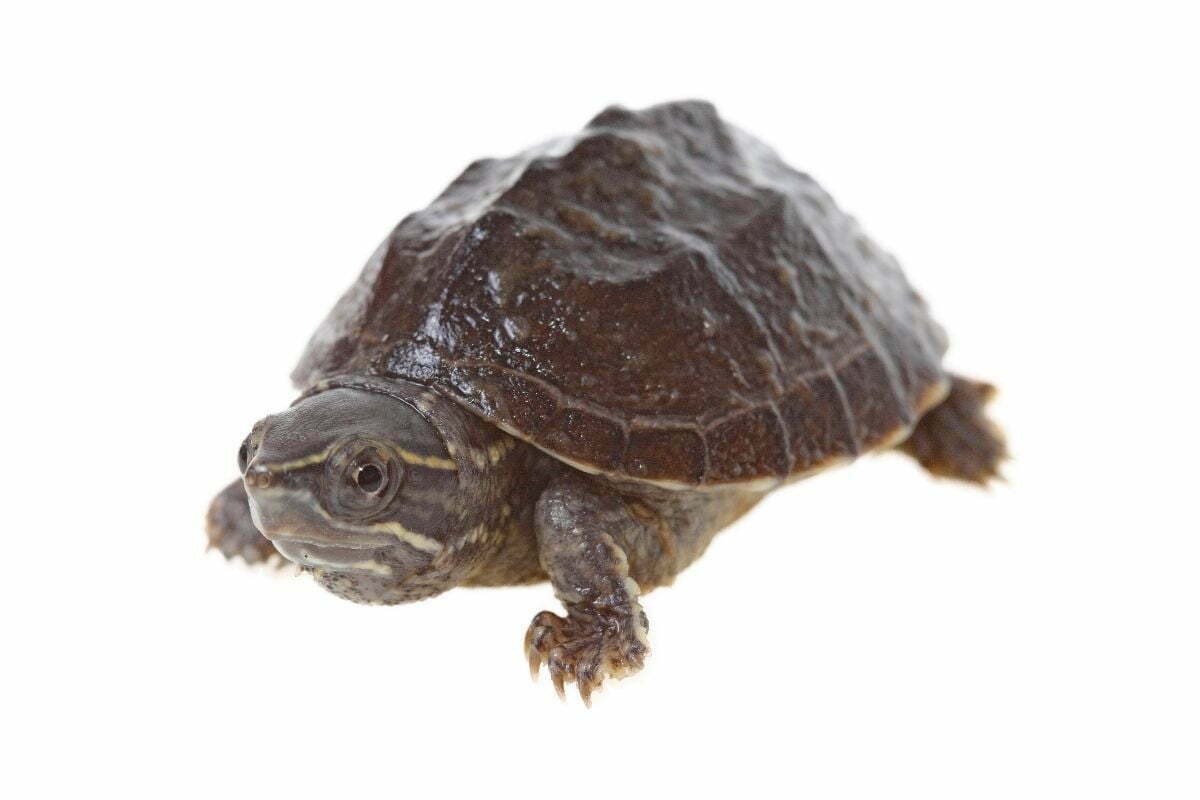
The Musk Turtle is one of those rare species of turtle that is almost always sold as a pet. It is also one of the most popular turtle species among people who want a pet because it is cute, friendly, and relatively easy to look after.
Also known as the stinkpot, it is a small-bodied turtle with a shell that can reach up to 6 inches in length. While males tend to grow smaller shells than females, both sexes have similar coloring.
The dorsal surface of the shell is typically light brown, with darker markings on its back and tail. The front half of the shell has a lighter tint, with darker lines and darker marks that run down the middle of its side.
The underside of the shell is often cream-colored, with a broad black stripe running down the center that runs between the plates of the turtle’s shell. Small wonder that so many people love it!
Requirements
These animals, like all other turtles, require a good amount of heat and light to thrive when kept indoors. You should make sure that your heat lamp output is high enough, as well as have the right amount of water for them in their aquarium.
Like striped turtles, this species isn’t the strongest swimmer, so make sure that your water levels for them are not too high. Otherwise, they may struggle to rest properly or otherwise drown.
The musk turtle is omnivorous, like most other species of turtles, though it tends to prefer eating shrimp trout, insects, and other carnivorous food bases. They can still eat some plants, however, such as duckweed.
If you can manage to source this plant near you, your little musk turtle will happily enjoy a little green with their fish and bugs!
Another thing to note with this species is that they can be quite hostile when people try to pick them up. In some cases, they will even secrete a terrible odor as a self-defense mechanism, hence their name.
Pros
- A unique-looking small turtle that will be a welcome addition to any family.
- Can eat a wide range of foods, from mealworms to duckweed.
Cons
- This can be quite an aggressive species, so do not underestimate its feisty spirit if you buy it as a pet.
8. Mud Turtle
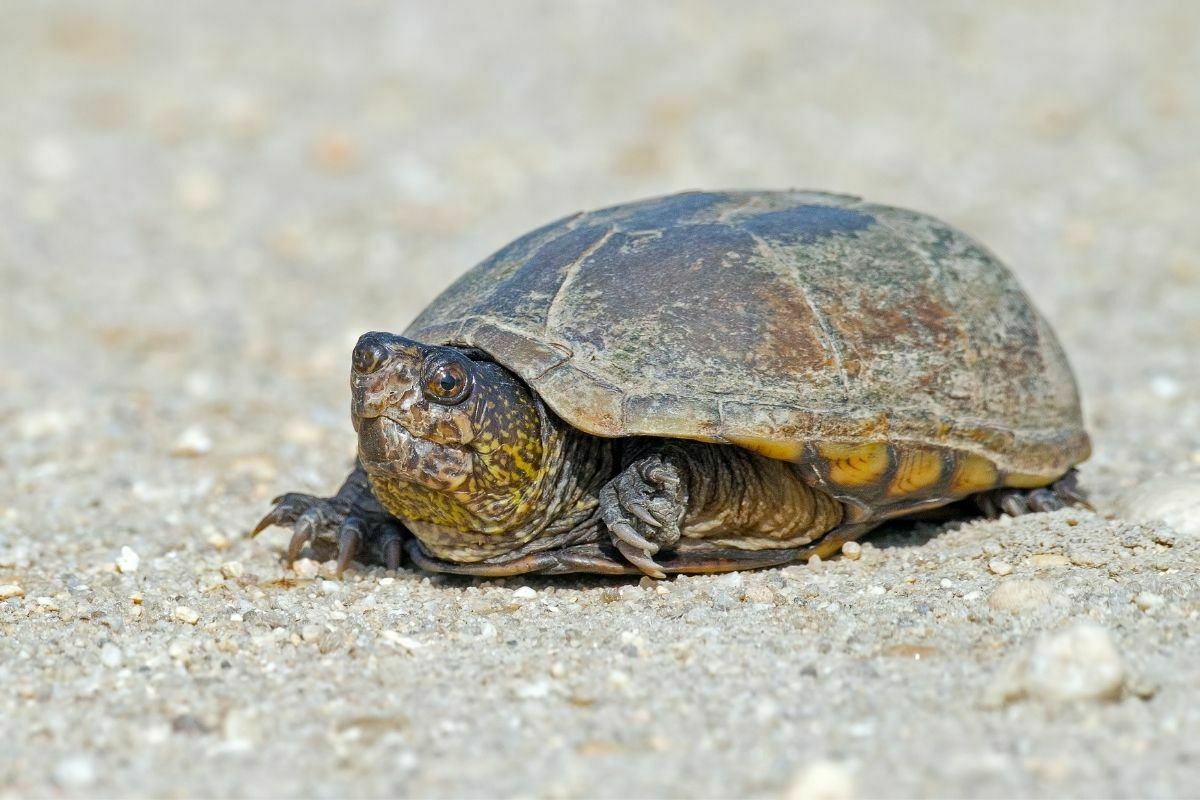
If you’re looking for something cute to add to your tank, then the Mud Turtle could be just what you’ve been searching for! This species of turtle is native to Southeast Asia but has since spread across the world due to human trade and migration.
It is the smallest species of turtle, measuring about 4 inches in size, although there is no set standard for how big they need to be for it to be considered a ‘turtle.’
As with other turtles, the mud turtle has a hard carapace encasing their body, which protects them when they come into contact with predators. Its shell is typically dark gray to blackish, with very few lines on the shell, outside the parts where the carapace meets.
While they don’t have a very distinct pattern on their carapace, they do have a large head, which makes them look larger than they are. And at only 5 inches at most, they don’t get very big at all!
They also have long legs, which gives them a more reptilian appearance. However, their feet are webbed, unlike reptiles, making them more amphibian-like.
Requirements
Mud turtles are not very strong swimmers. While they do enjoy crawling along the bottom of streams and rivers, they need to be kept in shallow water and with an easily reachable resting place above the water level of their tank.
Their diet consists mainly of worms, insects, and snails. They can sometimes feed on vegetables and fruit, though the latter is rare.
They do best in temperatures between 64 and 77 degrees Fahrenheit.
Some sources claim that these turtles can live for over 50 years, while others say that they will die in less than 20.
Pros
- These turtles make for lifelong companions, being able to live up to 50 years!
- An adorably small turtle species, at no more than 5 inches long!
Cons
- Like musk turtles, they will secrete a nasty odor if they feel threatened. Try not to stress your turtle out!
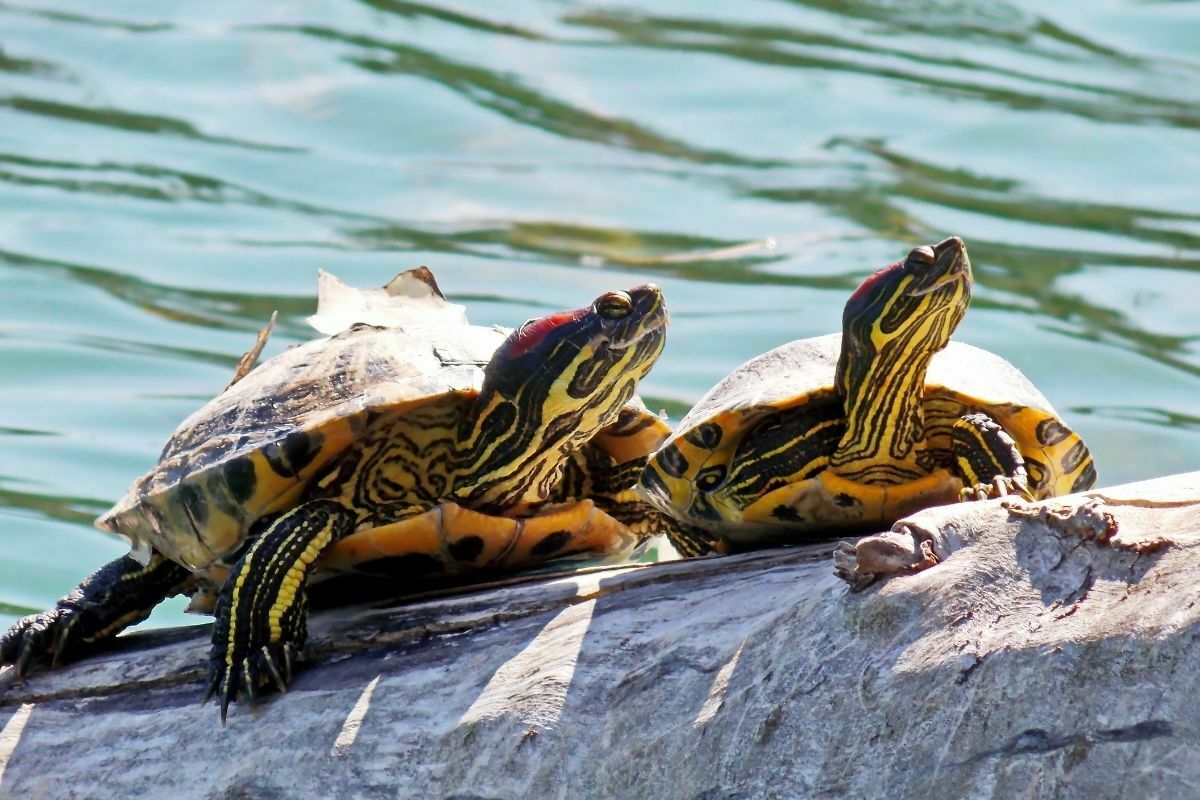
Frequently Asked Questions
Why Should You Keep Small Turtles As Pets?
These turtles are fairly easy to care for and require relatively low maintenance. Their lifespan is usually around 30 years, so if you plan on keeping one, then you won’t need to worry too much about having enough space or money to keep them happy.
Other than that, they tend to be pretty friendly but should always be approached gently.
How Do I Feed My Pet Turtle?
You’ll find yourself feeding your turtle various types of foods depending on its age and stage of development. The younger ones will mostly eat pellets and dry foods, whereas older ones may consume wet foods.
In general, you can expect your young baby turtles to eat approximately 3-4 times per week. Once you’ve got them past the baby stage, you might want to increase this amount slightly.
Mature turtles should eat every day. However, this depends on how active they are. If they aren’t moving around much, then you shouldn’t be worried about them eating too often.
However, if they are busier, you should encourage them to eat by giving them some veggies and fruits occasionally.
Can I Get Small Turtle Pets From The Wild?
Under no circumstances should you take wild animals from their native environment and raise them in your home. Not only is this damaging to their populations in the wild, but they can also carry several diseases on them.
Salmonella is a common bacterial infection that can be contracted from aquatic turtles in the wild.
It’s better to adopt one from a reputable breeder who has experience breeding reptiles. This way, you know exactly what kind of conditions the animal was born into, and you can ensure that it gets the best possible start in life.
Make sure that the seller is reputable too. Exotic turtle species are a very popular pet that is often illegally brought into the country. You should be sure that your seller of choice is an appropriate source to buy legal turtles from.
Conclusion
As you can see, there’s plenty to think about when buying a new pet turtle. It can be quite overwhelming, but we hope this article has helped answer all your questions and made things a little easier.
